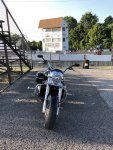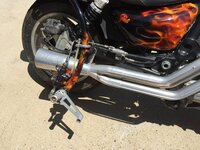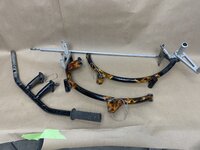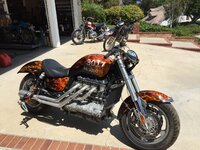SpazOnaR3
.060 Over
VP's C16 if we are running a gas class (or ERC's A8D, though they haven't been out at Bonneville for the past 2 years). In the Gas classes @ bonneville events you have to use a gas from the approved vendor... C16 is probably the beefiest gas that fits into that class, though they have a few other blends that are still considered gas (basically non-oxygenated fuels, a gross over-simplification, but it serves). In the Fuel classes you can run whatever ya like, but we usually leave the C16 in there and get it done, at least in the forced induction bikes. If it were an NA or nitrous bike I'd use something else.
1700 seems huge, but you have to take RPM into account with injector sizing, especially when you have less cylinders than normal for a given displacement. At high rpm you have less pulse time available, and you can easily saturate 2 or 3 single injectors. At 9500 rpm you have roughly 25ms of TOTAL time between ignition events on one cylinder. When you factor in dead dead time on each end of the pulse, plus the increased dead time at higher pressures and lower voltages (3 coils and a fuel pump at that RPM pull the electrical system down a bit), a recommended 80% duty cycle max for injectors, the higher BSFC from rich mixtures and retarded timing... you start running out of injector waaaaaay before you think you would (or most calculators will tell you).
Some people probably don't want to hear this, but the case for smaller injectors being adequate at higher HP numbers are usually either related to lower RPM applications or over inflated HP numbers, which is extremely common in the bike dyno world, more so on forced induction applications. If you see a CF higher than 1.01 on a forced induction dyno graph, you are going to get inflated numbers.... the higher the base correction and the more boost you run, the worse it actually is.
1700 seems huge, but you have to take RPM into account with injector sizing, especially when you have less cylinders than normal for a given displacement. At high rpm you have less pulse time available, and you can easily saturate 2 or 3 single injectors. At 9500 rpm you have roughly 25ms of TOTAL time between ignition events on one cylinder. When you factor in dead dead time on each end of the pulse, plus the increased dead time at higher pressures and lower voltages (3 coils and a fuel pump at that RPM pull the electrical system down a bit), a recommended 80% duty cycle max for injectors, the higher BSFC from rich mixtures and retarded timing... you start running out of injector waaaaaay before you think you would (or most calculators will tell you).
Some people probably don't want to hear this, but the case for smaller injectors being adequate at higher HP numbers are usually either related to lower RPM applications or over inflated HP numbers, which is extremely common in the bike dyno world, more so on forced induction applications. If you see a CF higher than 1.01 on a forced induction dyno graph, you are going to get inflated numbers.... the higher the base correction and the more boost you run, the worse it actually is.






